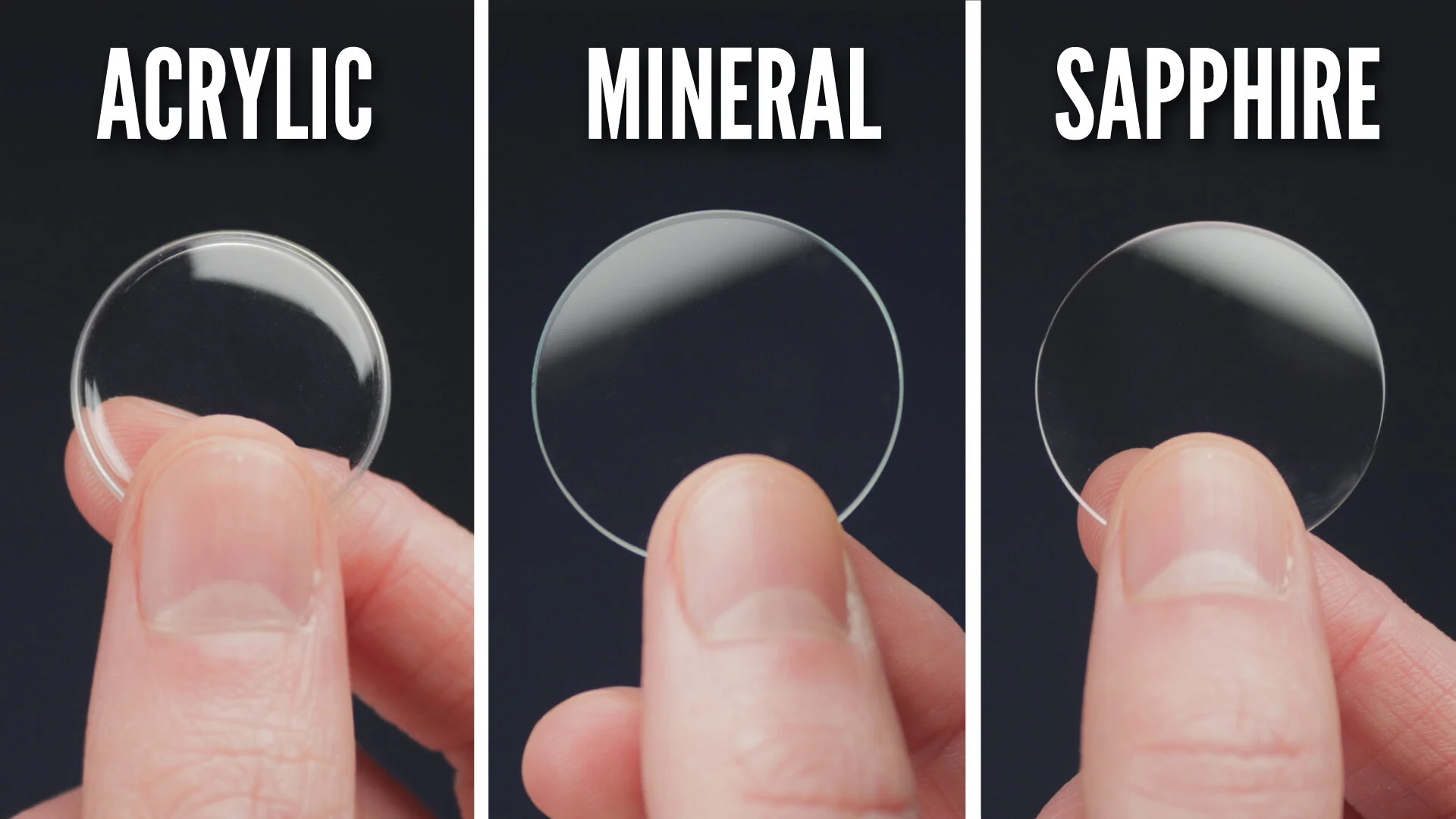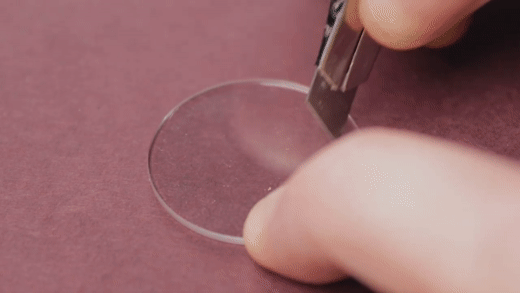Types Of Watch Glass – Which Is Best? Types Of Watch Crystals Explained
Wristwatches usually come fitted with some form of glass, to protect your watch dial and allow you to read the time. The question is, which watch glass is best? What are each of these glass types? How do they perform and compare to one another?
Well, here’s a quick guide to each type of watch glass, to help you discern which may suit your needs the best!
There are 3 general types of watch glass out there:
- Acrylic Crystal
- Mineral Crystal
- Sapphire Crystal
Each have slightly different properties, making them suited for particular situations and functions.
Acrylic Crystal / Acrylic Glass
Sometimes known under the pseudonyms ‘Hesalite’, ‘Perspex’ or ‘Plexiglass’, acrylic crystal is essentially a specialised form of plastic (polymethyl methacrylate), that is contoured to fit over a watch dial.
You will often find flat pieces of acrylic crystal fitted to extremely low-cost watches, due to its low retail cost. This type of glass is also often used on retro-inspired watches, as it can be effortlessly manipulated, allowing watchmakers to create domed glass very easily; creating a nice distortion when looked at from an angle. Overall, some people prefer the look of acrylic, whilst others think it looks cheap.
While acrylic glass is very affordable, its softness makes it very susceptible to scratches; though is surprisingly resistant to impacts, due to its flexibility. The pseudonyms previously mentioned are certain variants of acrylic glass with marginally different features, but overall very similar performance.
Pros:
Impact-resistant
Can easily buff out light scratches by polishing
Low cost
Cons:
Very easily scratched and marked
Multiple scratches can impair dial visibility
Considered by some to look ‘cheap’ (subjective)
Best for: Low cost watches, retro watches, practical dive watches.
Mineral Crystal / Mineral Glass
Sometimes known under the pseudonym ‘Hardlex’, mineral crystal is a popular choice for many entry-level watch brands, given its low price point.
Mineral glass is created from silica and provides better scratch protection than acrylic crystal, though from my experience still isn’t particularly good. This is almost identical to the regular ‘glass’ that you’ll have in your windowpanes and has similar properties as a result.
Mineral crystal is often found on ‘fashion watch’ brands, as it is cheap to manufacture and provides some scratch resistance.
Pros:
More scratch resistant than acrylic
Less reflective than sapphire
Quite impact-resistant
Cons:
Far less scratch resistant than sapphire
If damaged (i.e. cracked, heavily scratched or chipped), repairs generally aren’t possible; replacement crystal would be necessary
Can chip when impacted
Best for: General purpose lower-end watches, when sapphire is out of reach/budget.
Sapphire Crystal / Sapphire Glass
Usually the default choice for higher-end watches, to many Sapphire is the optimal material when it comes to watch glass; primarily because it is the hardest crystal available.
Most sapphire glass found in wristwatches is actually synthetic (man-made) sapphire, rather than the naturally occurring material you may be familiar with. As with acrylic, this isn’t technically ‘glass’, rather, transparent crystallised Aluminium Oxide; usually produced in a laboratory. You will struggle to scratch a sapphire crystal with anything other than a piece of diamond.
While sapphire performs well against scratches, it is somewhat susceptible to shattering if exposed to heavy impacts. This is why certain watch types, for instance army watches, opt for more shatter-resistant options like acrylic. Nevertheless, unless you are wearing the watch in a particularly manual job or plan on dropping your watch on to hard surfaces, it’s less important than you may think. I’m yet to ever smash a sapphire crystal.
Pros:
Unparalleled scratch resistance
Attractive appearance and colour
Enhanced visual clarity, anti-reflective coating can almost make this crystal ‘disappear’
Cons:
Higher cost
Prone to shattering upon heavy impacts
If damaged or smashed, repairs generally aren’t possible; replacement crystal would be necessary
Best for: Premium watches, where scratches are unwanted.
OTHER TYPES OF GLASS:
Sapphire-coated mineral crystal
A more recent innovation, sapphire-coated mineral glass seems to be increasing in popularity among microbrands. This is essentially a piece of mineral glass, with a layer of sapphire laminate coating on its surface. A notable example of this glass was previously used by Seiko, going by the name ‘Sapphlex’.
From my experience, this acts as some form of halfway house between mineral and sapphire. It’s often marketed as being the best of both, though I’ve heard reports of the sapphire layer chipping off or separating from the mineral glass in extreme cases. Thus, I tend to prefer regular sapphire glass. This coating was initially introduced as a cost-effective alternative to sapphire, though when the production costs of sapphire were decreased, the industry moved away from the coated stuff; which I think says something about its true performance.
Krysterna Crystal
An obscure watch glass, ‘Krysterna’ is the name given to the crystal used by the brand Stuhrling and its subsidiary Akribos brand.
Little is known about this material and its performance. Stuhrling make plenty of bold claims, marketing this as the best material for a watch dial. A primary selling point being that this glass is supposedly ‘more shatter resistant than sapphire crystal’, which sounds good at first. Nevertheless, as previously showcased, sapphire is the least shatter-resistant type of glass anyway; it doesn’t say a lot about the quality of Krysterna.
Source Credit - When It Comes To Crystal, Krysterna Is The Clear Choice - Stuhrling.com
From what others have said online, this seems to be closest to some form of hardened or coated mineral crystal. For the most part, the hype around Krysterna crystal seems to be creative marketing. Their scratch-resistance claims have also received mixed feedback from users online, so I wouldn’t just accept the brand’s claims at face value.
My Preference
Personally, I always like to look for sapphire glass when possible. In all honesty, I don’t find that glass makes a huge difference to a watch, it’s more like a nice-to-have feature. Nevertheless, I think for most people, scratch resistance is probably the most desirable property; you’re much more likely to scratch a watch crystal than smash it completely.
If I was after a watch specifically for use during physical activity, where impacts are far more likely, I may be tempted to go for an acrylic watch. Even though the scratches may be frustrating, the shatter-resistance could come in useful in certain situations. It’s why hardy watches like the Casio digital models utilise acrylic crystals; allowing them to withstand impacts.






